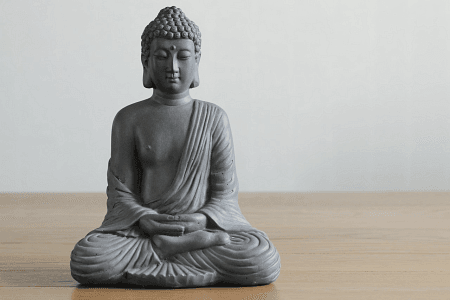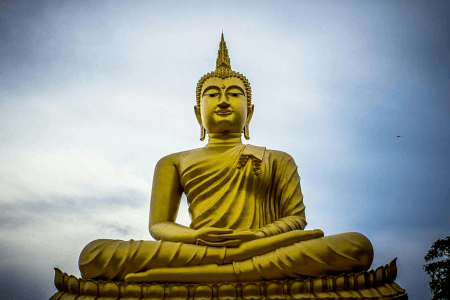Some modern home designs have incorporated Budha statues as decorative elements. While the statues have spiritual significance in some of these homes, they also create an aesthetic appeal.
Buddha statues in homes are an embodiment of deeper meanings and religious principles. For this reason, they need to have a proper placement to bring positive energy to the residential space.
This article will explore the cultural significance of Budha statues, the types of statues, and how to care for them.
Cultural Significance and Respect
Many homeowners have placed Budha statues in their modern homes because of their significant cultural implications. Visitors coming to such homes have to respectfully understand the origin of this culture to ensure good relations and respect.
Cultural Significance
For many people with these statues in their homes, Buddha statues aren’t just for decorating the home’s living space. These statues are symbols of the teachings of Siddhartha Gautama, the founder of Buddhism in the 6th- 4th century BCE.
Budha statues represent enlightenment, peace, and compassion which form the core philosophy of Budha. By placing the statues in modern homes, the homeowners are embodying the principles of enlightenment, peace, and compassion.
Respect for Buddha Statues
Respecting Buddha statues requires an individual to remember that the placement of these statues in homes comes from the rich traditions of Eastern societies practising Buddhism. These societies place the statues to remind themselves of the philosophy and desire for ethical living.
People have to consider the following facts to respect the culture of placing Buddha statues in modern homes:
- Buddha statues have different poses
- Each Buddha statue has a cultural context
- The placement is intentional according to Feng Shui
- Placement requires education in Buddhism
Shopping Guide
After understanding the cultural context of Buddha statues and appreciating the rich traditions of Eastern societies, a homeowner can buy the right Buddha statues and place them in their homes.
Homeowners can buy these cultural objects from wholesaler Phoenix Import and place them in rooms providing positive energy like living rooms, Meditation Rooms, or Altars. The material of the Buddha statue is a very important consideration.
Stone is durable and an ideal material for Buddha statues to be placed outside. Wood is another material for intricately carved statues. Metal and resin are also materials to choose from depending on the desired look and lightweight design.
Types of Buddha Statues for Home Design
Aside from the material of the Buddha statue, homeowners can choose from different style variations.
Traditional
These Buddha statues retain the original styles like the hai, Tibetan, and Japanese styles from the ancient Eastern societies. They contain intricate details showing the ancient cultures.
Modern
Modern Buddha statues don’t contain as many intricate patterns, appealing to minimalist aesthetics.
Artistic
These statues either have unique artistic elements or feature mixed media. They create an interesting twist on traditional Buddha statues.
Additionally, Buddha statues have different designs and poses:
- Dhyana Mudra
- Bhumisparsha Mudra
- Abhaya Mudra
Feng Shui Placement Guidelines
Feng Shui principles aim to make homeowners harmonise their living space. Feng Shui therefore guides people where to place their Buddha statues for a positive energy within the home.
According to the Principles of Feng Shui, people should place their Buddha statues in strategic locations within their homes:
- Living rooms
- Meditation Areas
- Entryway
- Bedroom
Modern Design Integration
Integrating Buddha statues in modern home designs involves incorporating traditional aesthetics into contemporary architectural styles. Stone or metal are the two most popular materials of Buddha statues offering a sleek look.
Homeowners want to place the statues in serene places like meditation spaces or living rooms to allow the positive energy to flow. A thoughtfully placed Buddha statue honours the rich culture of Eastern societies while complimenting a beautifully constructed contemporary home.
Common Mistakes to Avoid
Placing Buddha statues in a bathroom isn’t recommended as it doesn’t promote the flow of peaceful and positive energy associated with Buddha. People should also place the statue at an eye level or higher.
Placing the statue on the floor or anywhere lower is disrespectful to the cultural and spiritual background of Buddhism. Additionally, people should keep the space around the Buddha statue clutter-free to allow the positive energy to flow.
Size and Scale Guidelines

Smaller statues of up to 12 inches are ideal for desktop spaces, shelves and small alters. Medium-sized statues measuring 12 to 36 inches can be placed on tabletops or living areas. However, larger Buddha statues measuring over 36 inches are ideal for placing in gardens or spacious interiors.
Maintenance and Care
Cleaning Buddha statues regularly maintains their pristine condition. Dusting with a dry cloth prevents dirt buildup while cleaning with a damp cloth provides deeper cleaning. After cleaning the statues, place them away from direct sunlight.
It’s important to handle the statues respectfully while caring for them and maintaining their pristine condition. A gentle touch is required to avoid breaking the statue or something chipping away.
Conclusion
Buddha statues have a significant cultural and spiritual background. Placing them in a home requires you to understand the cultural and spiritual importance to ensure you place them in a spot that allows for a positive flow of energy.
Keeping the statues clean and the surrounding spaces clutter-free allows the positive energy to flow. At the same time, keeping the statues in appropriate spaces like living rooms and meditation rooms is also important.

